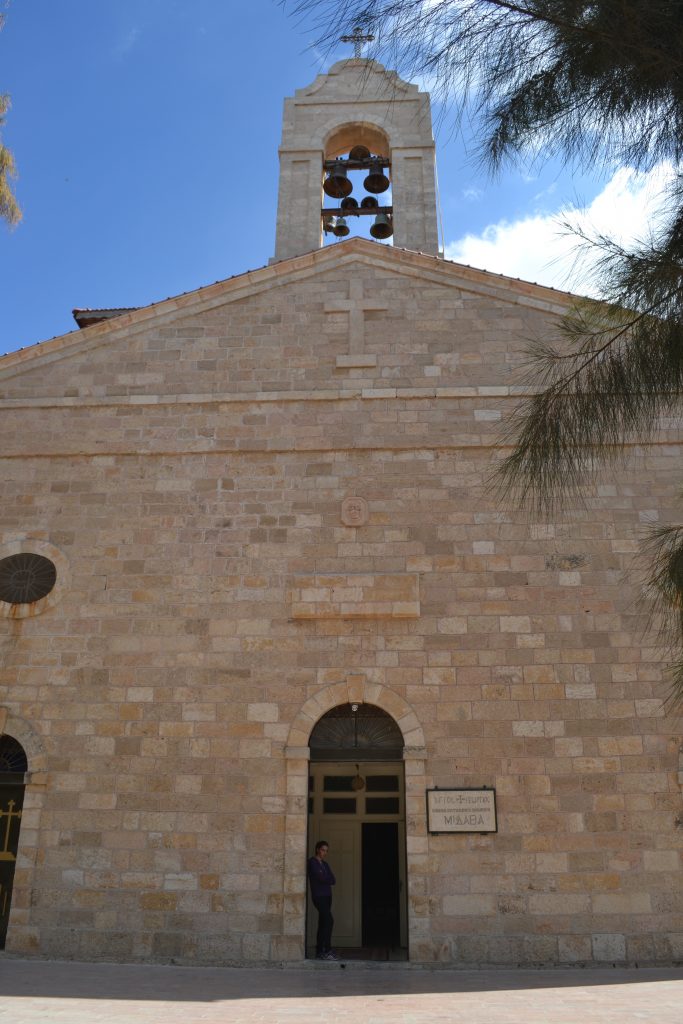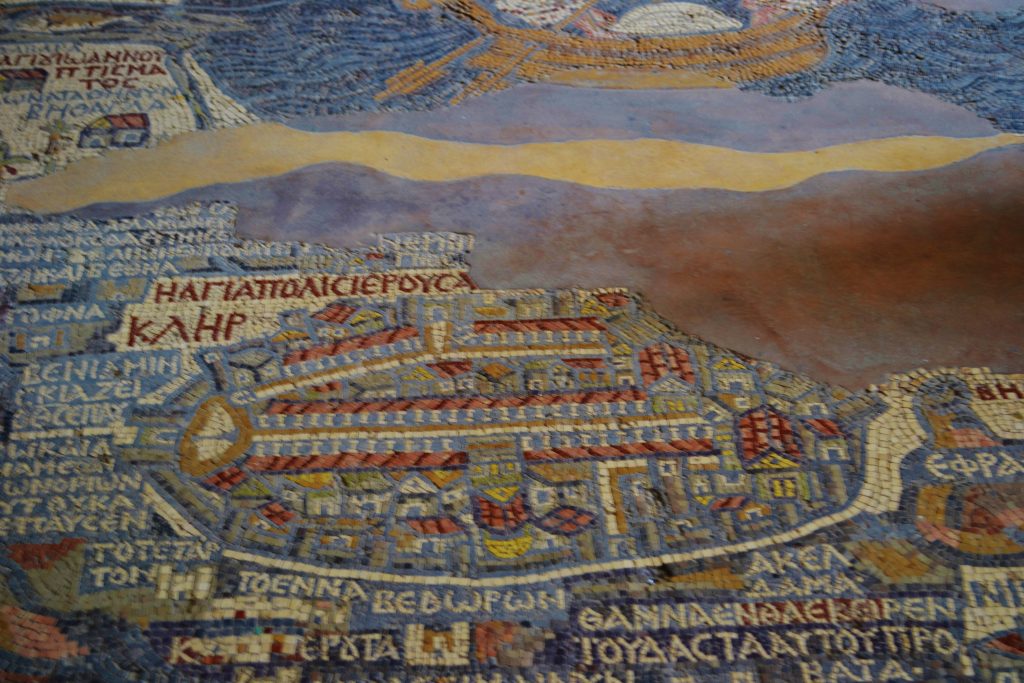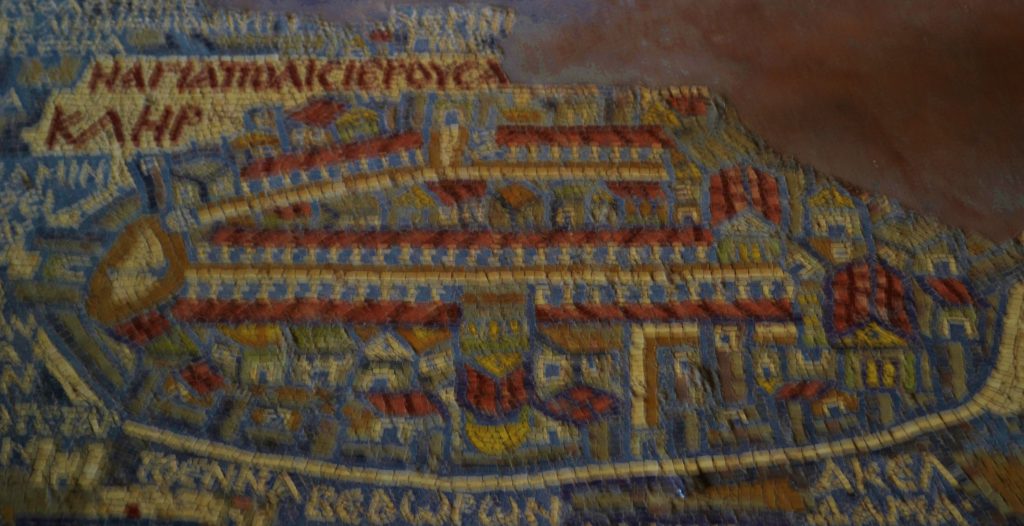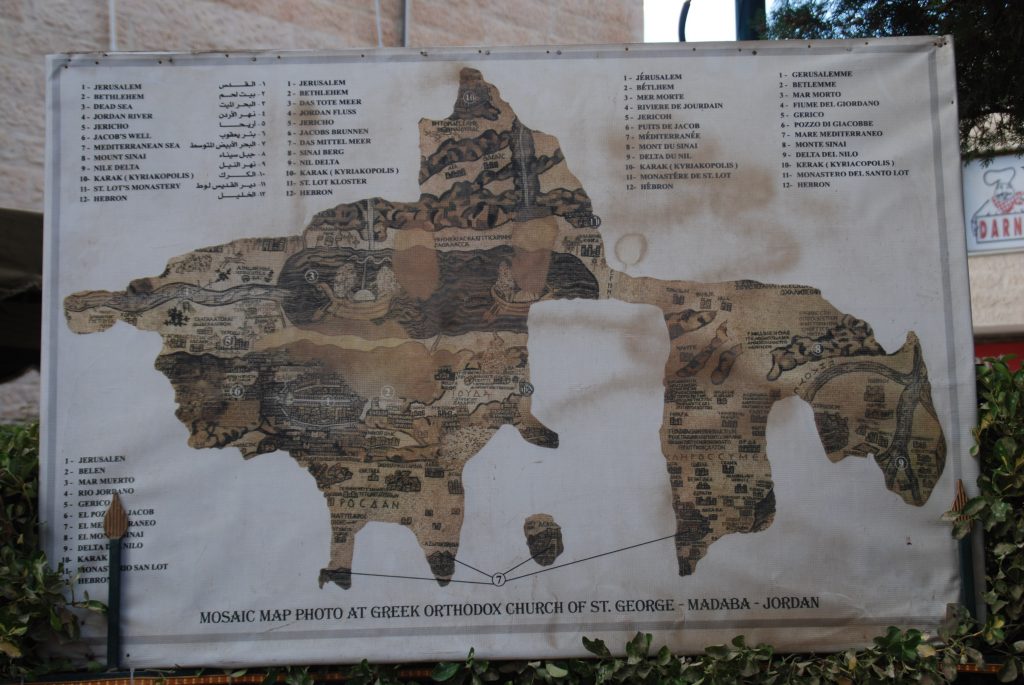
Our bus ride from Machaerus to Ma’daba took less than an hour, backtracking through the winding roads reaching the Dead Sea. Conveniently located off of the King’s Highway in Jordan, is the charming town of Ma’daba, the “City of Mosaics”. Home to hundreds of Byzantine-era mosaics, the most famous is the Ma’daba Map, the oldest known surviving map to include the city of Jerusalem.
Before entering the site where the map is housed, we stood before a placard which pointed out some of the highlights on a replica diagram. We would be able to locate the Dead Sea, the Jordan River and the city of Jerusalem as it appeared during Roman times.

Housed in St. George’s Church in Ma’daba’s town center, the map of two million colored local stones dates back to the 6th century AD. Visitors can view this phenomenal masterpiece which is beautifully laid out on the floor of the church, a detailed map of the Holy Land. The oval city within the mosaic shows ancient Jerusalem after it was rebuilt by Roman Emperor Hadrian in the 2nd century AD. Renamed Aelia Capitolina, several landmarks are prevalent within the map which also demonstrates the layout of Rome’s city planning. On the far left of the city, the Damascus Gate led into a circular plaza which once displayed the Column of Hadrian. From here, the main street ran from west to east as displayed with a yellow line referred to as the Cardo Maximus (David Street). Red roof tiles sheltered the sidewalks and protected the shops from inclement weather. By this time, the Church of the Holy Sepulchre had been built and was located south/central of the Old City as shown on the map.
The oval city within the mosaic shows ancient Jerusalem after it was rebuilt by Roman Emperor Hadrian in the 2nd century AD. Renamed Aelia Capitolina, several landmarks are prevalent within the map which also demonstrates the layout of Rome’s city planning. On the far left of the city, the Damascus Gate led into a circular plaza which once displayed the Column of Hadrian. From here, the main street ran from west to east as displayed with a yellow line referred to as the Cardo Maximus (David Street). Red roof tiles sheltered the sidewalks and protected the shops from inclement weather. By this time, the Church of the Holy Sepulchre had been built and was located south/central of the Old City as shown on the map.
A strong Christian heritage thrives in this beautiful Jordanian town Ma’daba once settled by the Moabites. Abandoned since the 16th century, a group of Christians revived this village and were permitted to build churches only on the sites where the old ones once stood. While making way for the new construction of St. George’s Church, the Ma’daba map was discovered. Unfortunately, the mosaic was found in bad condition. In 1965, German archaeologists restored and conserved what remained of the map and today it is a thriving attraction where approximately 1000 visitors arrive daily.
Have you visited Ma’daba and seen the extraordinary Ma’daba map? I would love to hear from you if you will kindly leave a message in the comments section below. Many thanks for reading about my experience in Jordan and wishing you many Happy Travels!
What to See and What to Do:
St. George’s Church
Home of the Madaba Map
Talal St. 30
Madaba, Jordan
- Admission Fee: All Visitors: 2 Jordanian Dollars; There are several tours that include the Madaba Map with Mt. Nebo and the Dead Sea which you can find online.
- Hours: Open 8:30 AM to 6 PM Monday through Thursday and Saturday; open Friday and Sunday from 10:30 AM to 6 PM.
- Length of Visit: 1 hour or less
- Tips for Your Visit: Arrive early to avoid afternoon crowds as this is a popular stop for tours. Take a photo of the detailed diagram outside which shows the placement of various items on the map.
Where to Stay:
Crowne Plaza Dead Sea
Ein Bokek, Dead Sea
Telephone: 08 659 1919
This hotel was luxury at its best. Built along the shores of the Dead Sea, the Crowne Plaza offers a wide range of luxury services.
Where to Eat:
Abu Yousef
Ash Shuhada Street
Madaba, Jordan
A local favorite, this restaurant has been providing Madaba fresh hummus, falafel and schawarma for over thirty years. Open 8 AM to 1 PM daily.
What to Eat:
- Falafel are crisp balls made of chickpeas and is a staple street food of Jordan.
- Fattet Hummus is a chickpea based spread which also includes pieces of pita bread, tahini, pine nuts and topped with a generous portion of olive oil.
- Kunafa was one of my favorite desserts from Jordan made of a pastry and stuffed with cheese and syrup.
- Mansaf is Jordan’s national dish. This aromatic meal is served family style and layered beginning with a thin flatbread, rice, meat (camel or goat) then garnished with toasted nuts and yogurt.
- Maqluba was served at our Jordanian local dinner with a Christian family. Our host brought a large pan filled with chicken, rice, potatoes and vegetables and turned the pan upside down on a large plate. One of the tasty spices in this dish is sumac, so I purchased several bags of this spice to bring home.
- Shawarma is a pita bread filled with lamb, chicken or beef.
- Zaarb is traditionally cooked over a campfire. A stew-like meal made of beef and vegetables, it is traditionally cooked in a pit.
What to Read:
- The Map of Madaba, by Douglas R. Roper
- Married to a Bedouin, Marguerite van Geldermalsen
- Leap of Faith, by Queen Noor
- Appointment with Death, by Agatha Christie
- Pillars of Salt, by Fadia Faqir
- The Tower, by Allesandro Gallenzi
- Seven Pillars of Wisdom, by T.E. Lawrence
